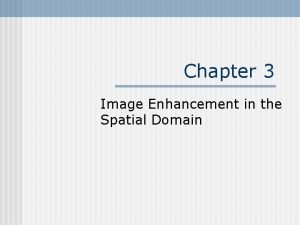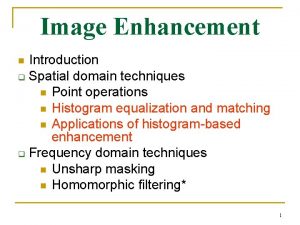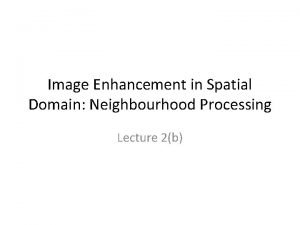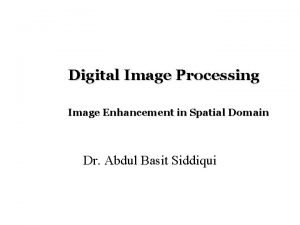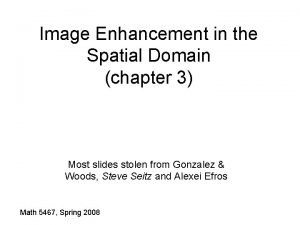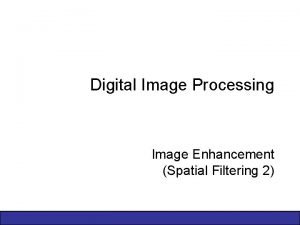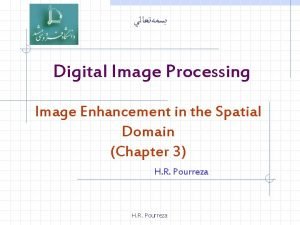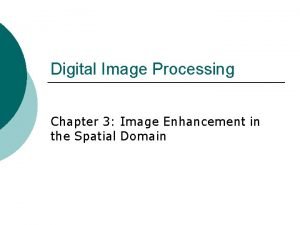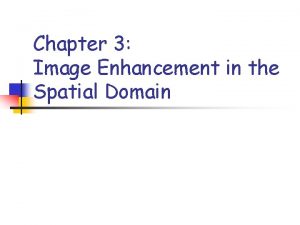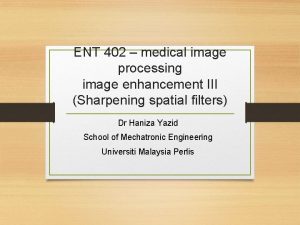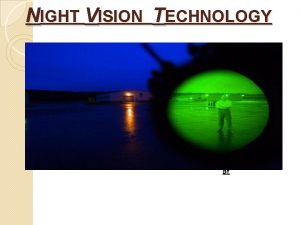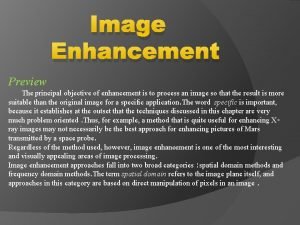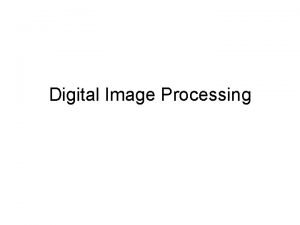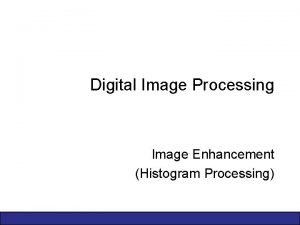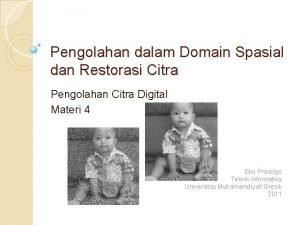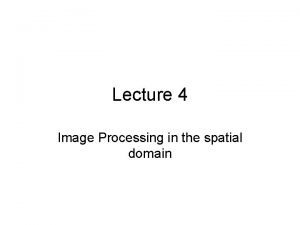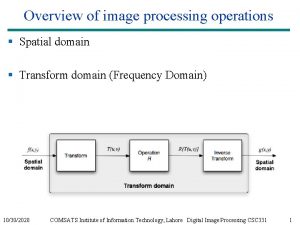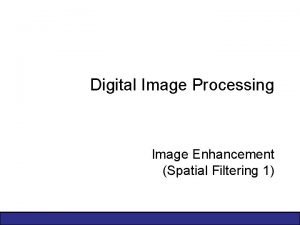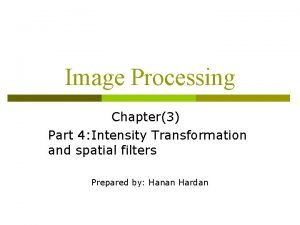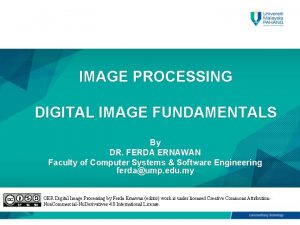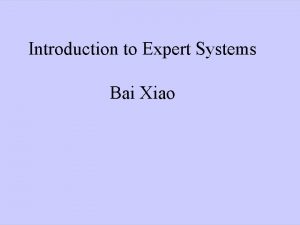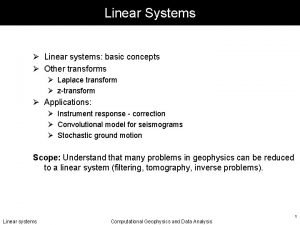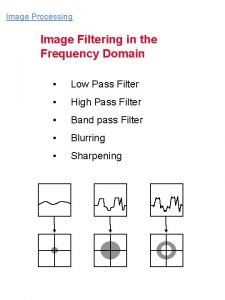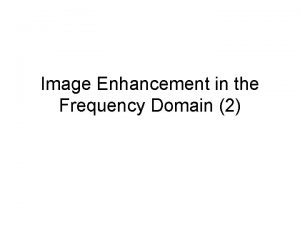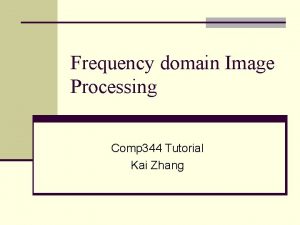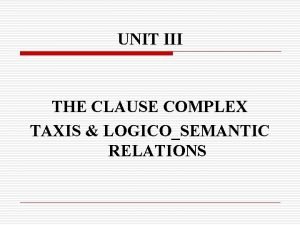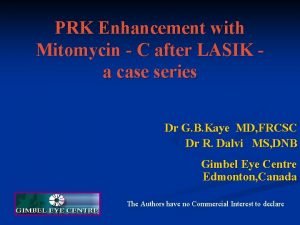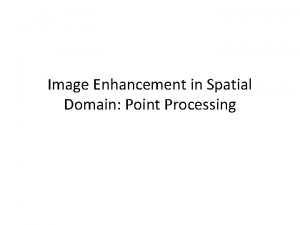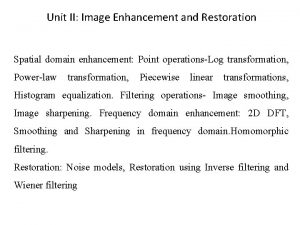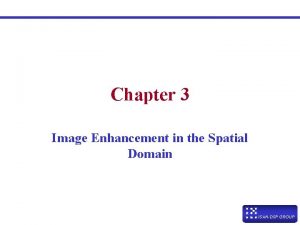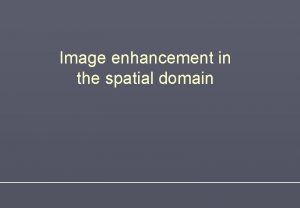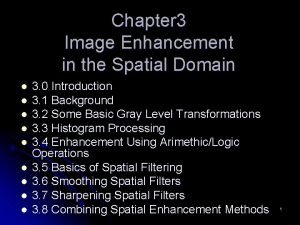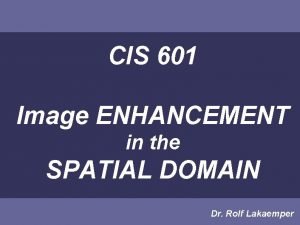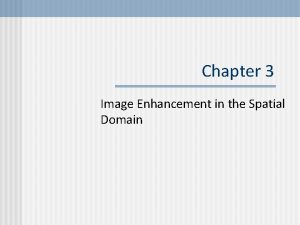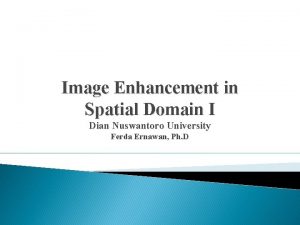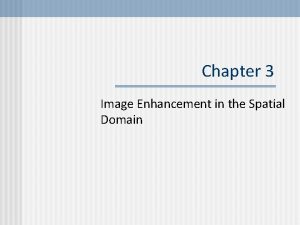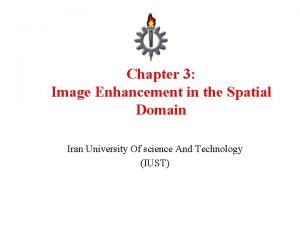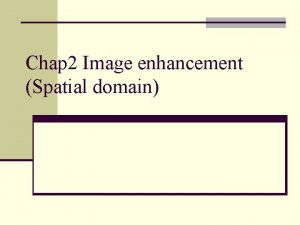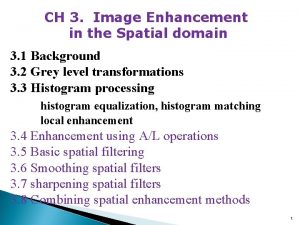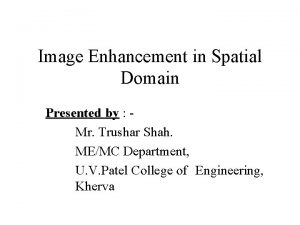CH 3 Image Enhancement in the Spatial domain










































- Slides: 42

CH 3. Image Enhancement in the Spatial domain 3. 1 Background 3. 2 Grey level transformations 3. 3 Histogram processing histogram equalization, histogram matching local enhancement 3. 4 Enhancement using A/L operations 3. 5 Basic spatial filtering 3. 6 Smoothing spatial filters 3. 7 Sharpening spatial filters 3. 8 Combining spatial enhancement methods 1

3. 4 Enhancement using A/L operations Masking- selecting subimages in an image - Referring to as ROI (region of interest) processing - In term of enhancement, isolating an area for processing Arithmetic operations: Addition, Subtraction, Multiplication: used to implement gray-level rather than binary Division: Logic operations: And: used for masking (Fig. 3. 27) Or: used for masking Not operation: negative transformation Also are used in conjunction with morphological operations 2

Enhancement using arithmetic/logic operations 3

3. 4. 1 Image subtraction The difference between two images f(x, y) and h(x, y): g(x, y) = f(x, y) - h(x, y) Enhance the difference part of two images Contrast stretching transformation—useful for evaluating the effect of setting to zero the lower-order planes (Fig. 3. 28(d)) 4

Enhancement using arithmetic/logic operations 5

Enhancement using arithmetic/logic operations E. g. Image subtraction: Mask mode radiography (Fig 3. 29) g(x, y) = f(x, y) - h(x, y) : h(x, y) is the mask 6

3. 4. 2 Image averaging 7

Enhancement using arithmetic/logic operations 8

3. 5 Basics of Spatial Filtering 9

Basics of Spatial Filtering 10

Chapter 3 Intensity Transformations and Spatial Filtering

Chapter 3 Intensity Transformations and Spatial Filtering

3. 6 Smoothing Spatial Filters q Used for blurring and for noise reduction. § Blurring is used for removal of detail and bridging of small gaps in lines or curves. Smoothing linear filters q Averaging filter (low pass filter) § Replace the value of every pixel by the average of the gray levels in the neighborhood by the filter mask Reduce sharp transition (such as random noise), : side effect - blurring edges § E. g. The average of the gray levels in the 3 x 3 neighborhoods 13

3. 6. 1 Smoothing linear filters § (a) Box filter: coefficients = 1 § (b) Weighted averaging: give more weight to some pixels 14

Smoothing Spatial Filters Increasing filter mask size =3, 5, 9, 15, 35 15

Smoothing Spatial Filters 16

3. 6. 2 Order Statistics filters (rank filters) u Nonlinear spatial filter based on ordering (ranking) • Median filter § Remove impulse noises (salt and pepper noises) § Represent 50 th percent of a ranked set § Large clusters are affected considerably less • Max filter (100 th percentile filter) useful in finding the brightest points • Min filter (0 th percentile filter) 17

Smoothing Spatial Filters 18

3. 7 Sharpening Spatial Filters Sharpening spatial filter • Highlighting fine detail or • Enhancing detail that has been blurred § Application ranging from electronic printing and medical imaging to industrial inspection § Can be accomplished by digital differentiation 19

3. 7. 1 Foundation § Sharpening filter based on first- and second-order derivatives § Definition for first derivatives in terms of differences • Must be zero in flat segment • Muse be nonzero at the onset of a gray level step or ramp • Must be nonzero along ramps § 20

21

Sharpening Spatial Filters § Definition for second derivatives: is better suited than the firstderivative for image enhancement • Must be zero in flat areas • Muse be nonzero at the onset and end of a gray level step or ramp • Must be zero along ramps of constant slope 22

Sharpening Spatial Filters 23

§ Properties of first derivate: • produce “thick” edges • has a strong response to gray-level step § Properties of a second order derivate: • a stronger response to fine detail such as thin line and isolated points • produces a double response to a gray-level step change 24

3. 7. 2 Use of 2 nd Derivatives for Enhancement - Laplacian Development of the method (Laplacian) A function of f(x, y) of two variables is defined as Filter mask used to implement the Laplacian (Fig. 3. 39) ◦ Various versions: Diagonal, the sign of center value

Image Enhancement in the Spatial Domain

To overcome the shortcoming of the operation ◦ Enhance small detail and preserve background tonality “recover” background features while preserving the sharpening effect By adding the original f(x, y) and Laplacian images (Fig. 3. 40) A negative center coefficient--subtract sharpen result A positive center coefficient—add sharpen result

Sharpening Spatial Filters 28

29

Simplification (Laplacian filtering step + adding original image step one step) • Composite Laplacian mask - no diagonal neighbors • Diagonal neighbors—sharper than no diagonal neighbors 30

Sharpening Spatial Filters 31

Unsharp masking and high-boost filtering Un-sharp masking: The dark room photography ◦ subtract a blurred version of an image from the image itself high-boost filtering: A further generalization of un-sharp masking

Un-sharp Masking and High-boost Filtering The center coefficient of the Laplacian mask: negative or positive High-boost filtering is used when the original image is blurred and dark. 33

34

35

Un-sharp Masking and High-boost Filtering 36

3. 7. 2 Use of 1 st Derivatives for Enhancement - Gradient First derivatives in image processing are implemented using the magnitude of the gradient. 37

Use of First Derivatives for Enhancement Gradient Robert operators Sobel operators Roberts operator Gx = (z 9 -z 5) and Gy = (z 8 - z 6) Sobel operator Gx = (z 3+2 z 6 +z 9) - (z 1+2 z 4+z 7) and Gy = (z 7+2 z 8+z 9) - (z 1+2 z 2+z 3) 38

Use of First Derivatives for Enhancement Gradient 39

3. 8 Combining Spatial Enhancement Methods 40

Combining Spatial Enhancement Methods 41

Summary 3. 4 Enhancement using A/L operations ◦ Image subtraction, Image averaging 3. 5 Basic spatial filtering ◦ Convolution, correlation, mask, kernel etc. 3. 6 Smoothing spatial filters ◦ Linear filter(averaging filter), Order-static filters (median, max, min filters) 3. 7 Sharpening spatial filters ◦ 2 nd derivative (Laplacian), Unsharp masking, high -boost filter, 1 st der. (Robert, Sobel) 3. 8 Combining spatial enhancement methods
 Spatial filtering
Spatial filtering Image enhancement in spatial domain
Image enhancement in spatial domain Image enhancement in spatial domain
Image enhancement in spatial domain Image enhancement in spatial domain
Image enhancement in spatial domain What is enhancement in the spatial domain?
What is enhancement in the spatial domain? Image processing
Image processing The objective of sharpening spatial filter is to
The objective of sharpening spatial filter is to Mask mode radiography
Mask mode radiography Combining spatial enhancement methods
Combining spatial enhancement methods Idl medical ent
Idl medical ent Oflinemaps
Oflinemaps Image enhancement in night vision technology
Image enhancement in night vision technology Objective of image enhancement
Objective of image enhancement Gamma correction image processing
Gamma correction image processing Point processing in image processing
Point processing in image processing Grey level slicing
Grey level slicing Gonzalez
Gonzalez Arithmetic
Arithmetic Spatial domain
Spatial domain Spatial operations in image processing
Spatial operations in image processing Spatial filtering in digital image processing
Spatial filtering in digital image processing Intensity transformations and spatial filtering
Intensity transformations and spatial filtering Fundamentals of image compression
Fundamentals of image compression Spatial resolution in digital image processing
Spatial resolution in digital image processing Introduction to functions (review game)
Introduction to functions (review game) Z domain to frequency domain
Z domain to frequency domain Data domain fundamentals
Data domain fundamentals Common z transform pairs
Common z transform pairs The z transform of np
The z transform of np Domain specific vs domain general
Domain specific vs domain general Domain specific vs domain general
Domain specific vs domain general Problem domain vs knowledge domain
Problem domain vs knowledge domain S domain to z domain
S domain to z domain What are language processing activities
What are language processing activities Band pass filter in image processing
Band pass filter in image processing Frequency domain image
Frequency domain image Nnnnnf
Nnnnnf Complex sentence
Complex sentence Family enhancement center
Family enhancement center Scodix ultra 101 price
Scodix ultra 101 price Prk enhancement
Prk enhancement Static power dissipation in nmos inverter
Static power dissipation in nmos inverter Mre
Mre
